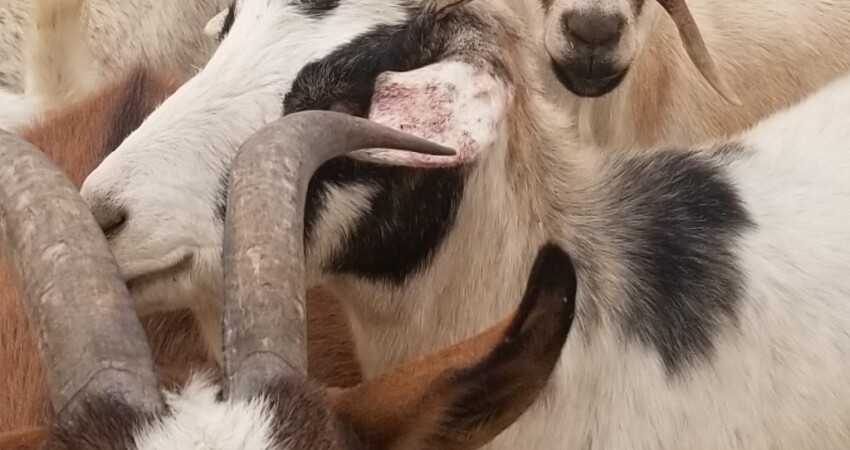

Horns crack, chip, and break. Depending on where in the horn structure this occurs, a goat horn injury can range from unremarkable to life-threatening.
Goat horns are made of bone covered by a keratin sheath. They do not shed, like antlers. The bone has a blood supply and is living; the keratin does not. The tip is the oldest part of the horn and is solid keratin, and the horn base is a cavity open to the skull and sinus. Where the horn meets the skull are ossicones, which are responsible for horn growth. If a goat is disbudded, or the horn base is injured, and the ossicones are not completely destroyed, abnormal horn growth called scurs will result.
If a goat horn breaks or cracks at the tip or has a shallow chip along the shaft, it will not bleed and generally requires no care except to remove any damaged parts and smooth the remaining horn. A horn broken in the keratin region, just like a fingernail, will not knit back together, as the growth areas are limited to the ossicones. Some people attempt to glue, splint, or fill the broken area, but the patch is usually unsuccessful.
How to trim goat horns if broken: saw wire and sandpaper, or a Dremel tool, are effective for minor horn care. The goat has no sensation in this area of the horn, and so the procedures are painless.
When the horn breaks in the vascularized area, there will be significant bleeding. Injuries in this area vary from partial to complete breaks, degloving, or rupture of the horn from the skull. It is important to stabilize the horn in these injuries, remove any loosely attached parts, staunch the blood flow, and monitor for infection. This area has a blood supply and is enervated, so it is extremely painful for the goat. Medication for pain management may be needed depending on the extent of the injury. In fly season, use a fly repellant. If the goat has not had a cd/t vaccination within six months, administer CD/T antitoxin for bleed injuries.
Partial Break
In this case, you can opt to leave the horn’s broken portion to allow the vascularized area to clot and heal. Once healed, the fragile, broken tip fell off. If removing the broken area, be prepared to apply pressure to stem the blood flow and apply a clotting agent — spiderwebs, styptic powder, cornstarch, or turmeric. If you cannot stop the blood flow, you may cauterize it using a disbudding iron, and if none available, a red-hot piece of iron. Apply pressure to the bleeding area a second or two at a time. Do not apply first aid products to cauterized tissue, as it needs to remain dry. Cover the injury for a few days if flies or contamination are a risk.
Deglove
Degloving is when the keratin sheath is removed, leaving only the bone tissue. As with other injuries, control bleeding, apply antiseptic, and monitor for problems. A degloving can re-bleed when bumped and will continue to weep moisture for quite some time. The bone will usually dry, given time, but it is essential to protect from infection and flies. The keratin sheath is not likely to regrow. Some owners opt for a surgical dehorning.
Base Break
A goat horn broken from the skull base is an emergency. Owners should seek veterinary care if possible. The sinus cavity will be exposed and must be covered to protect it from debris until it has healed. It takes time and diligent care, continually monitoring for infection. The timeline for healing is unpredictable and depends on many factors, including the goat’s age and condition. Isolate the goat to prevent stress or further injury. If a veterinarian is not available, flush the cavity with a sterile solution to remove any debris. Cover with gauze and wrap the head securely. Change the dressing every few days. Do not leave the area unprotected until the cavity closes.
Depending on the extent of the horn injury, the horn may or may not grow back. Some goat horns injured at the base, or scurs that erupt from improper disbudding, will grow at an unusual angle and require trimming. It is best to limit trimming to the horn’s keratin portion, and trim using a wire saw to avoid splitting the horn.
It is not always possible to prevent goat horn injuries. Goats use their horns in a variety of ways — including clashing with other goats as well as stationary objects. Nutrition plays an important part in horn strength, particularly calcium, phosphorus, manganese, magnesium, and copper. Goats of all ages should always have access to a loose mineral formulated for goats. To be prepared to manage horn injuries, a goats first aid kit should include a blood stop agent, a wire saw, a sanding block, a cauterizing tool, gauze, wrap, antiseptics, antibiotics, pain management medication, and fly repellant.
 Contact Jaguza Support
Contact Jaguza Support